Soil for adenium: the correct composition of the substrate for the plant
Adenium is a flower that has migrated to home conditions from exotic countries. It belongs to the group of succulents that need a specific kind of land, special maintenance and constant care. Although the tree has a capricious disposition, it is distinguished by its original flowering and interesting appearance.
Not many growers take the risk of growing an interesting flower. But if the growing process is successful, then a tree with an interesting root system and unforgettable color. The main point of planting is the choice of quality soil.
Content:
- Indoor plant description
- What should the soil be made of?
- How to choose the right container?
- Growing conditions
- How to care and when to transplant?
- Diseases and pests, the fight against them
Indoor plant description
Adenium is an extraordinary plant. It is an insignificant tree that thickens from the base, rising upward in a cone. Its roots creep out, intertwine with each other, forming original plexuses and an extraordinary appearance. The crown of adenium has a bright green or deep dark shade, depending on the variety. When flowering, unusual bright inflorescences are revealed throughout the branches. Due to the active budding, the ornamental tree was nicknamed the Star of Sabinia, the Desert Rose, and the Impala Lily.
Adenium is a deciduous exotic tree.
Its genealogy goes back to the Kutrov dynasty. The first appearance of a non-standard plant is determined in several regions such as Thailand, North Africa and in some regions of Malaysia. In natural wild conditions, adenium is not a miniature indoor plant at all, not reaching even 60 cm, but a massive huge tree. In favorable conditions of tropical forests, it can grow in height from 3 meters to 10 m. The tree has a caudex - a strong thickening in the lower part of the trunk, which tapers towards the top, diverging in numerous branches.
Stems and branches are covered with bark, specific to the touch, grayish smooth structure. In some periods of growth, the shade of the outer cover can change to grayish green to dark brown. The thickening of the trunk ends with several sturdy branches on which leathery, glossy leaves grow. The greens have a rich dark color. The leaf plates are attached to the branches with a small petiole.
The leaf shape is presented in lanceolate or oval shape. The leaves are straight along the edge, ending in a sharp little end. Each leaf is bent towards the central part, and has the shape of a boat. The length of the plate is from 7 to 15 cm. The first flowering of adenium occurs at 2 years of age. The buds begin to develop in early June. Throughout the summer period, flowering occurs, old inflorescences die off and new ones form. The duration of the produced process ends at the end of September.
Various types of exotic species differ not only in the diameter of the flowers, but also in the color of the petals.The size of the opened bud is 3-13 cm, and the colors vary from pink to yellow, from red to red-black, as well as white and peach colors.
There are some of the most popular types of adeniums:
- Obesum is the most common exotic tree in Russia. Flowering occurs in May, the diameter of the inflorescences is 7 cm. Flowers are presented in a pink or scarlet shade.
- Arabic - the appearance of buds is recorded in May and lasts until the first days of October. The buds stand out in a bright pink tone. In winter, it completely loses all the foliage and goes into hibernation until warm spring days.
- Socotransky is a dwarf plant. It has gray leaves and pale pink, closer to a peach tone.
- Somali - flowering begins from the moment when the tree reaches 15 cm in height, and most importantly, lasts all year, continuously.
Thus, adenium is a unique interesting plant that amazes with its types of flowers, appearance and structure. Good care provokes high-quality growth and long-term flowering of large inflorescences.
What should the soil be made of?
Soil for adenium is the main condition for the favorable growth and development of both the root system and trunk, as well as branches with flower buds. Watering, although it is one of the main means of caring for an exotic, is not enough if the tree is planted in the wrong soil.
It is recommended to take nutritious, loose and balanced soil.
Acidity for planting, the plant must be at a neutral level. If you are buying a ready-made substrate for succulents in a specialized store, then you should carefully read the instructions on the package. If the acidity contains a pH of 5.8, then such a soil mixture is acidic. Otherwise, the elevated level - pH - 7 is alkaline. Neither option nor the second is suitable for growing an exotic plant.
If you decide to independently prepare the soil for planting, you should choose one of the options for preparing the soil substrate:
- Option 1 - river sand (10%), perlite (25%), 505 soil for succulents, vermiculite (15%).
- Option 2 - peat (50% of the total batch), vermiculite, which can be replaced with river sand (20%) and garden simple leaf land (30%).
It is very important that the soil is loose, dense and heavy substrate, it is difficult for the nutrient moisture to pass through, and after that it dries out for a long period. At the same time, a sufficient amount of oxygen required for active growth does not penetrate into the soil. This negatively affects the succulent root system.
How to choose the right container?
In order for the adenium to feel good in a new place, it is recommended to take a low pot, but wide in diameter. The main condition is wide drainage holes on the bottom of the flowerpot. If you plan to grow succulent seedlings, it is recommended to purchase peat cassettes. They will hold a young seedling both convenient and comfortable.
If you choose the right potting mix, you can choose a clay pot or plastic pot.
The ceramic container quickly evaporates the incoming moisture, but at the same time supplies a sufficient amount of oxygen. During the growth of the plant, it tends to grow in width, therefore, a shallow but wide flowerpot is needed.
The root system, increasing in volume, begins to support the walls of the pot. In the case of a plastic pot, nothing can happen, but if the planting was carried out in a ceramic pot, then the rhizomes of the succulent can easily destroy the walls of the vessel. Therefore, in most cases, it is recommended to take a rounded bowl for planting an exotic seedling.
Growing conditions
For high-quality growth and active growth of the root system and ground volume, you should carefully monitor the care of the young seedling.Only the right influences and care for the flower will allow you to get an adult, original plant with bright large flowers.
In order for the care of the plant to be correct, the following recommendations should be followed:
- Lighting - the plant requires a lot of sunlight. It is not afraid of baking bright rays at lunchtime. Therefore, it should be placed on the southern windows. In winter, it is recommended to additionally highlight the plant. If suddenly the tree begins to stretch and turn pale, then this is a clear sign of a lack of lighting.
- Temperature - succulents come from hot countries, therefore the optimum temperature for them is air degrees from +26 .. + 35 C. During the dormant period, it is not necessary to specifically reduce the temperature in the room, there may be further favorable degrees for development. But if necessary, the plant also tolerates temperatures of +10 .. + 13 C.
- Humidity - in most cases, in urban apartments, both in summer and in winter, the indoor air remains dry. If for other plants it is necessary to constantly maintain a certain humidity, then for adenium, an increased temperature and dry air are favorable conditions.
The main thing is not to rearrange the plant from place to place. The tree must learn to live according to its natural clock. If you remove the flowerpot for the winter in a dark place and do not put it on the south side in time, then the leaves that appear will burn the first rays of the sun when moving. Otherwise, if the flowerpot will stand all year in one place, then the foliage will wake up along with all nature.
How to care and when to transplant?
For care, in addition to lighting, humidity and temperature, other procedures should be carried out. The following rules for caring for an exotic are distinguished:
- Spraying - you can periodically spray the leaves of the plant, but excessive irrigation provokes the accumulation of moisture in the joints of the foliage. The latter circumstance leads to decay of the site. If moisture gets on the inflorescences, then they soon begin to fade, unable to withstand a certain duration of flowering. In the fall, it is forbidden to carry out any spraying.
- Watering - on summer days in hot weather, watering is required for the succulent. When watering, the flowing water must be immediately removed from the sump. Do not wait for the soil to dry completely. If the soil in the flowerpot is half dry, then it is time to introduce nutrient moisture. In winter, daily watering is not required. The frequency of the event is reduced to 1 time in 4 weeks.
- Top dressing - carried out during the growing season, which is in spring and summer. Fertilizers should be purchased mineral dressing for succulents or cacti. You can also use houseplant fertilizer, but in this case it is better to use half of the required dosage. The last feeding is carried out either in the last days of August, or in the first decade of September. Fertilization activities should be carried out no more than once a month.
- Pruning - produced in spring time for that. So that the tree begins to bush and branch. This is necessary for lush flowering. Inflorescences, forming at the ends of the branches, stay open for 1 week. Then they begin to wither and fall off the plant.
- A transplant is a mandatory event, performed once every 1-3 years. This is required for the plant to grow more, gain strength and stretch upward. It is at the age of three that the root system grows significantly, so the hatched flowerpot no longer suffices for the tree. The transplant is carried out in such a way as to eliminate as much soil as possible from all the roots. Clean rhizomes are planted in fresh soil with new nutrients and minerals. Such transshipment has a beneficial effect on the further growth and development of the young tree.
Thus, not all recommended care measures should be followed.So spraying for adenium can only make it worse. Therefore, it is worth looking after your own pet and controlling its condition.
Diseases and pests, the fight against them
Due to the fact that the plant is poisonous, it is practically not affected by diseases or pests. The invasion of parasitic insects is possible only with improper tree care.
In this case, the following pests can settle on the leaves and branches:
- Spider mite.
- Shield.
- Mealybug.
For preventive measures, spraying should be applied once every 6 months. chemical insecticide... In addition, you can use a solution diluted with water and Actellic in order to disinfect the soil under the adenium. If the tree is periodically poured, then root rot may appear on the rhizomes. In this case, decay of rhizomes is observed, the acquisition of a yellow tint by the foliage and its fall from the branches. In order not to cause a similar situation, you should reduce watering and use light soil for planting.
If the plant begins to shed foliage for no reason, this may indicate that a flowerpot is in the path of a draft.
To resume the normal state, you need to rearrange the flowerpot to a new place. The lack of flowering indicates incorrect pruning in the spring. More careful measures should be taken to eliminate unnecessary branches for more intense branching and the formation of flower buds.
Thus, adenium is a rather demanding succulent. He is used to being in hot climates and dry air. Therefore, the restructuring to high humidity and frequent watering affects him in an unfavorable way. It is recommended to follow all the rules of care and monitor the condition of the plant.
More information about the composition of the soil for a plant can be found in the video:



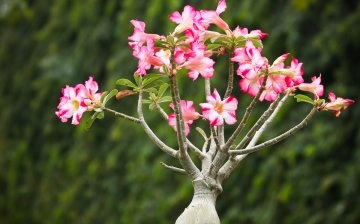
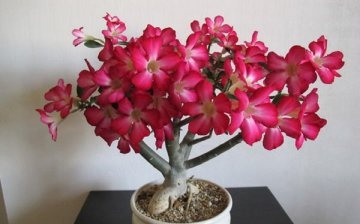
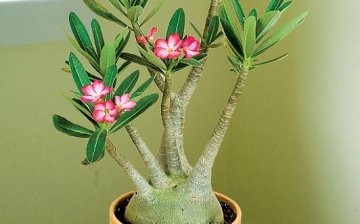
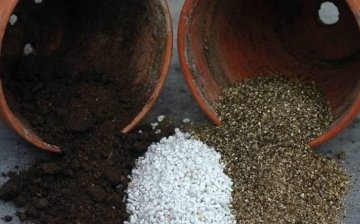
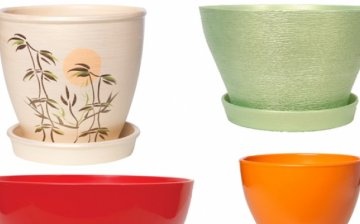
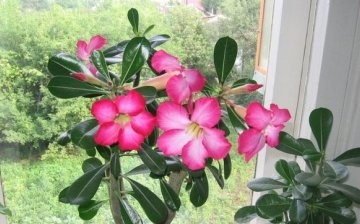

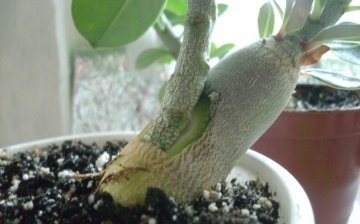








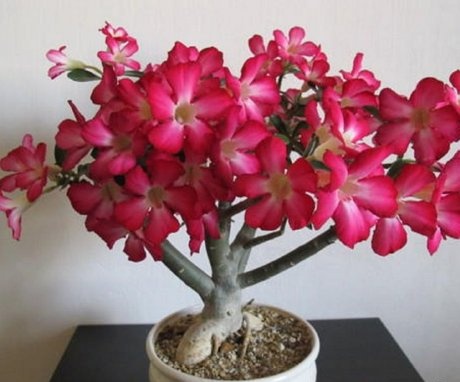
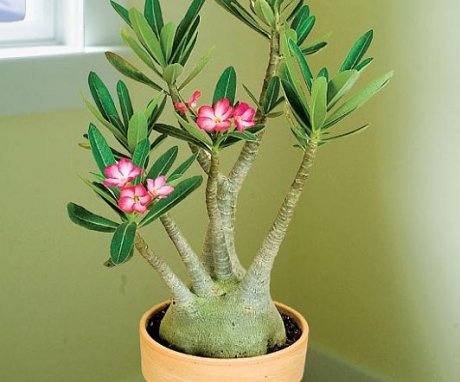
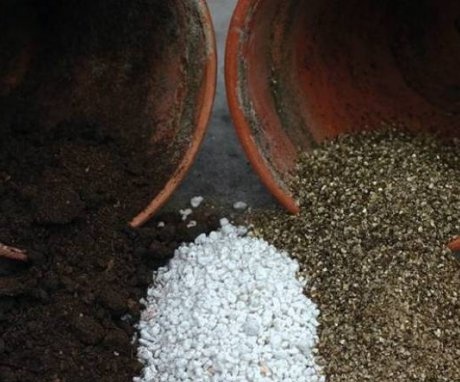
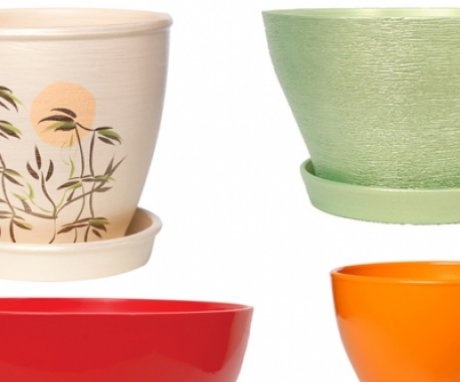
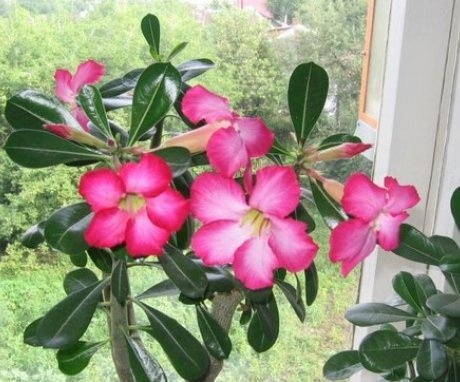
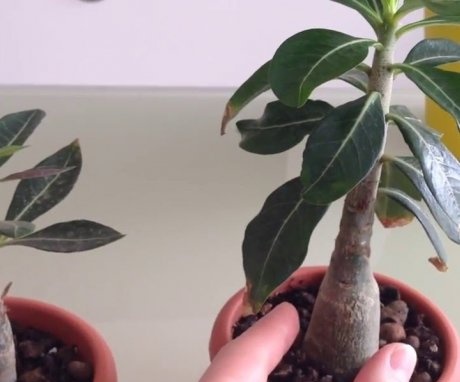
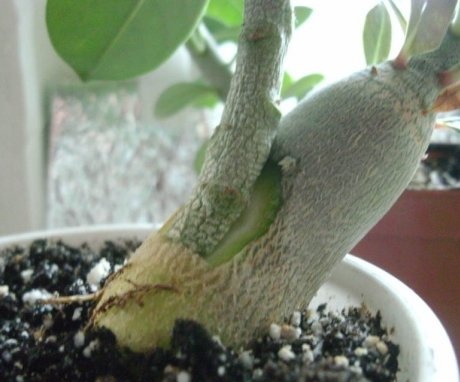
I tried to plant such a color in an apartment with my wife and it did not take root with us. Now I will try to work on the soil, which I think plays a key role in the survival rate of this flower.